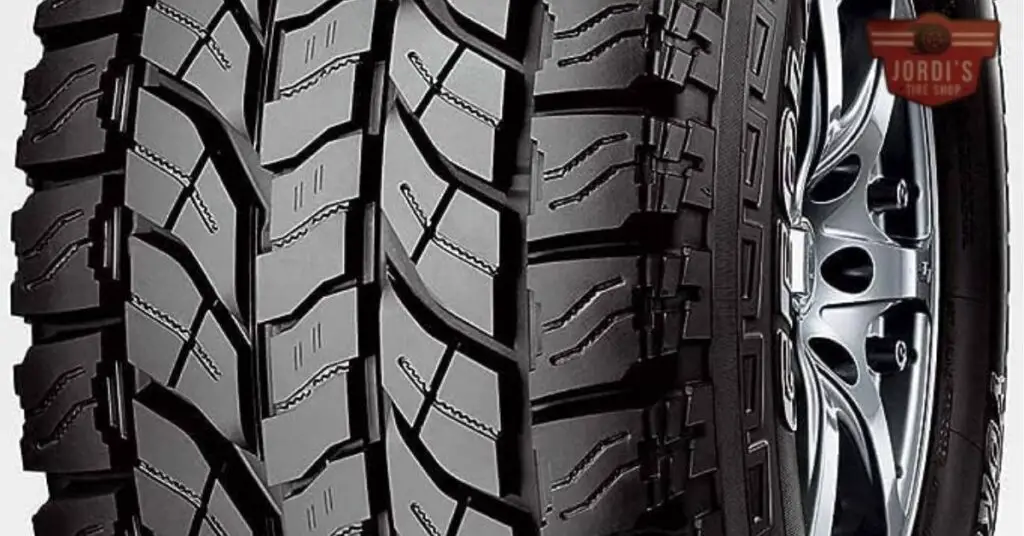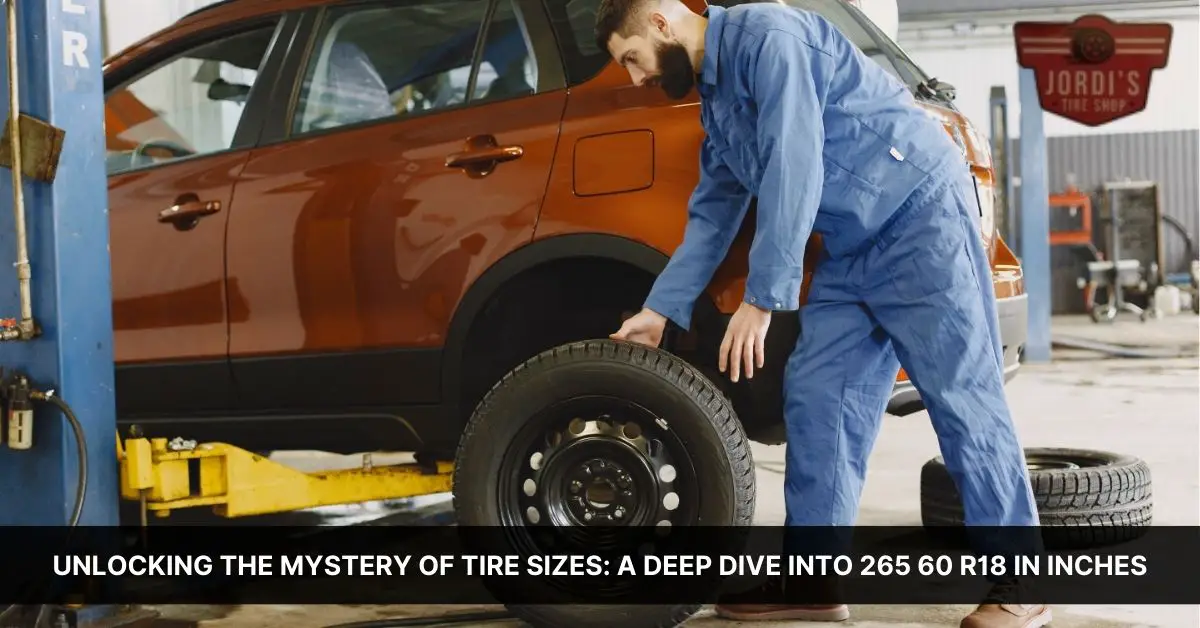Ever puzzled over the cryptic tire size numbers on your car’s sidewall? You’re not alone. Let’s demystify one such example, “265 60 r18”. This seemingly random string of numbers and letters actually holds a wealth of information about your tire’s specifications.
Understanding the Tire Size Notation: 265 60 r18

Imagine squinting at your vehicle’s tire, looking at the cryptic “265 60 r18”. It’s not a secret code—it’s information detailing your tire’s measurements. Let’s decipher it.
The Meaning of the Numbers and Letter
Pondering the sequence of “265 60 r18” might make anyone’s head spin. But don’t fret—it’s simpler than it appears. The first in line, “265”, stands for the tire’s width in millimeters. That’s about 10.43 inches, if you’d prefer non-metric.
Dig a little deeper, and the “60” pops out. This, in fact, represents your tire’s aspect ratio, suggesting that the height is 60% of the tire’s width.
Your gaze might now fall on the lone “r”—it signifies the construction of your tire, with ‘r’ translating to radial, the most common type.
The final component, “18”, indicates the diameter of the wheel the tire fits onto, expressed in inches.
The Importance of Correct Tire Size
Accurately figuring out the tire sizes, like “265 60 r18”, matters more than you might think. Drive with the wrong tire size, and you’ve got a problem. It’s about safety, fuel economy, and even legal requirements.
Off-kilter tire sizes possibly interfere with your vehicle’s accuracy—braking distances may increase, speedometers may be inaccurate.
Fuel efficiency takes a hit too—wrong tire sizes increase rolling resistance, so increasing consumption.
Also, driving with incorrect tire dimensions might push you into the area of illegality. Laws in certain jurisdictions mandate that your tires must be of specified sizes, suitable for your vehicle.
Deciphering the string of numbers and letters on your tires isn’t just for show—it’s crucial for optimum and lawful vehicle operation.
Conversion of 265 60 r18 to Inches

Exploring further into the industry of car tires, it’s essential to understand conversion into more familiar measurements. In the case of a “265 60 r18” tire, you’ll need to convert its width and diameter from millimeters to inches.
Breakdown of Individual Measurements
Let’s start by converting the tire’s width. The number 265 represents the tire’s breadth in millimeters. To convert it to inches, divide 265 by 25.4, which equals roughly 10.43 inches. That means the tire’s width is around 10.43 inches.
Next up is the tire’s aspect ratio expressed as 60. Remember, this figure indicates that the height of the tire is 60% of its width. Calculating 60% of 10.43 inches gives us approximately 6.26 inches. The tire’s height, hence, measures an estimated 6.26 inches.
Finally, you have the wheel diameter – denoted as 18, already presented in inches. Hence, no conversion is necessary for this part.
You might wonder why we’re explicitly focusing on these conversions. It’s because using familiar measurements can deepen your understanding and makes comparing tire sizes more intuitive.
The Complete Conversion
Taking together all these measurements, a “265 60 r18” tire converts to a tire having around 10.43 inches in width, about 6.26 inches in height, and an 18-inch wheel diameter. This useful conversion can aid you in making more informed decisions when handling various tire sizes.
Remember, understanding these conversions assists in maintaining your car’s optimal performance, legal compliance, and most importantly, ensures safety on the road.
Comparison with Other Popular Tire Sizes
In this section, we investigate deeper into the industry of tire sizes, specifically contrasting the size “265 60 r18” with other popular choices. We’ll explore the impact differing widths and diameters have on vehicle performance and stability.
Same Diameter, Different Width: How it Affects Performance
Switching to a tire with the same diameter as the “265 60 r18” but with a different width can bring about considerable changes in your vehicle’s performance. For example, a wider tire significantly increases the contact area between the tire and the road. This can boost grip, handling, and braking performance, especially in dry conditions.
But, it’s not all perfect with wider tires. They may negatively affect fuel economy due to the increased rolling resistance. On top of that, wider tires increase hydroplaning risk in wet conditions due to a larger water channeling area. Hence, it’s not always about bigger being better – the right tire width for your vehicle is dependent on several factors, including your driving style, driving conditions, and vehicle load.
Different Diameter, Same Width: Implications on Stability and Speed
Moving to a different diameter while maintaining the same width as the “265 60 r18” also comes with its set of effects. A larger diameter tire, while providing more ground clearance, can lead to a higher center of gravity. This may impact vehicle stability, especially on sharp bends or during rapid maneuvers.
On the other hand, a smaller diameter tire decreases ground clearance and potentially increases vehicle stability due to a lower center of gravity. But, this also might result in a stiffer ride as lesser tire sidewall is available to cushion road imperfections.
In terms of speed, a larger diameter tire will cover more ground in one revolution. This means your vehicle could show a lower speed than it’s actually going. Conversely, a smaller diameter tire will show a higher speed than you’re truly driving due to the smaller covered distance per revolution.
Remember, any changes to tire size should be conducted following legal requirements and manufacturer guidelines. It’s crucial to understand these changes and their implications before making a final decision, ensuring you maintain optimal vehicle performance, adherence to legal requirements, and, above all, safety on the road.
Ideal Vehicles for 265 60 r18 Tires

Optimal vehicle performance and road safety hinge on correct tire size. Specifically, the 265 60 r18 tire size matches particular vehicle categories.
Passenger Cars and Compact SUVs
The “265 60 r18” tires fit passenger cars and compact SUVs well. These vehicles, for instance, the Chevrolet Equinox and Ford Escape, readily accommodate this tire size. Their designs, incorporating exact torque and suspension settings, synchronize smoothly with the tire’s dimensions. This synchronization delivers precision steering, balanced handling, and minimal road noise.
Light Trucks and Larger SUVs
In light trucks and larger SUVs category, the 265 60 r18 tire size demonstrates adaptability. Let’s take the GMC Sierra and Toyota Land Cruiser as examples. These vehicles offer greater ground clearance and high-load capacity. With these 265 60 r18 tires, they support heavier weights, provide traction on various terrains, and negotiate harsh weather conditions effectively. Tire size agreement with vehicle specifications keeps performance optimal and ensures safety while on the move.
Tips for Maintaining 265 60 r18 Tires

Longevity and performance of your “265 60 r18” tires can be enhanced with effective management. Know-how of imperative maintenance techniques delivers on optimized performance and forges a path for secure on-road operations.
Regular Tire Inspection and Maintenance
To ensure the tires are in top condition, a regular inspection is essential. Look at tread depth, checking for uneven wear. With a depth of 1/16th of an inch, tire replacement is legally necessitated, as anything below can increase the risk of accidents. Besides, inspect for visible damage like cracks, bulges, or objects lodged in the tire.
Perform routine maintenance tasks; regular rotation, alignment check, and balancing are mandatory. Tyre rotation, typically every 5,000 to 7,000 miles, can offset uneven wear. Balancing, adjusted during a tire change or rotation, helps prevent vibration. Alignment, recommended annually or when new tires are installed, ensures optimum vehicle handling.
Impact of Proper Tire Inflation
Correct inflation of your “265 60 r18” tires significantly impacts their performance and your safety. Under-inflation results in excessive stress and heat, potentially leading to tire failure, while over-inflation can cause rapid wear along the center tread and hinder vehicle handling.
Experts recommend checking tire pressure at least once a month and before long trips, preferably when the tires are cool. Your vehicle’s manufacturer will provide the optimal tire pressure levels, usually located in the car manual or on a sticker inside the driver’s side door.
An investment in a good quality tire pressure gauge makes checking easy and precise. Regularly maintaining proper tire pressure not only safely maximizes the tire’s performance but also optimizes fuel efficiency, reducing long-term operating costs.
Conclusion
You’ve now navigated the complexities of tire size notation, specifically “265 60 r18”. You’ve learned that “265” is the tire’s width in millimeters, “60” is the aspect ratio, “r” means radial construction, and “18” is the wheel diameter in inches. You’ve seen how these numbers convert into inches and how understanding these conversions can help you maintain your vehicle’s performance and safety.
You’ve also explored how this tire size compares to others and how changing widths and diameters can impact your vehicle’s performance and stability. You’ve discovered that the “265 60 r18” size is a versatile choice, fitting a range of vehicles from passenger cars to larger SUVs.
Finally, you’ve picked up tips on maintaining your “265 60 r18” tires. From regular inspections to correct inflation, you now know how to extend your tires’ lifespan and ensure optimal handling. With this knowledge, you’re well-equipped to keep your vehicle running smoothly and safely on the road.
What does the tire size “265 60 r18” mean?
“265 60 r18” is a tire size notation. “265” refers to the tire’s width in millimeters, “60” is the aspect ratio showing that the height is 60% of the width, “r” means the tire has radial construction, and “18” shows the wheel’s diameter in inches.
Why is tire size important?
Tire size is crucial for safety, fuel economy, and legality. Wrong tire dimensions can result in longer braking distance, inaccurate speedometer readings, and potential legal issues.
How is tire size converted to more familiar measurements?
The tire size “265 60 r18” translates to approximately 10.43 inches in width, 6.26 inches in height (60% of the width), and 18 inches in wheel diameter.
How can changing tire dimensions impact vehicle performance?
Changing to a wider tire can improve grip and handling but may increase fuel usage and hydroplaning risk. Tweaking the diameter can affect stability and speed. Larger diameters offer more ground clearance but may compromise stability.
What vehicles are ideal for “265 60 r18” tires?
The “265 60 r18” tires are suitable for passenger cars and compact SUVs needing precise steering and balanced handling. They synchronise well with light trucks and larger SUVs that need to support heavier loads and provide varied traction.
How can the longevity of “265 60 r18” tires be enhanced?
Longevity of “265 60 r18” tires can be enhanced by regular inspections, routine maintenance including tire rotation, alignment checks, and proper inflation. This helps prevent uneven wear, ensures optimal handling and improves fuel efficiency.
Related Posts:
- Decoding Tire Size: Understanding 275 65r18 Dimensions in Inches
- Unraveling the Code: Your Comprehensive Guide to 275 70r18 Inch Tires
- Decoding Tire Sizes: How to Convert 265 70R18 into Inches for Smarter Tire Choices
- Demystifying Tire Sizes: An In-Depth Review and Buyers Guide for 285 75r18 Tires
- Decoding Tire Size: Unraveling the Mystery of 295 75r18 in Inches
- Decoding 275 60R18 Tire Size: A Comprehensive Inch-by-Inch Breakdown for US Drivers
- Decoding 285 70r18 Tire Size: A Comprehensive Guide in Inches
- Unraveling the Mystery: Converting 315 70R18 Tire Size into Inches for Optimal Performance
- Unlock Your Ride’s Potential: All You Need to Know About 325 65r18 Inch Tires
- Unlocking the Mystery of Tire Sizes: A Deep Dive into 265 60 r18 in Inches
- Decoding Tire Sizes: Understanding the 295 70 x 18 Tire Dimensions
- Unlocking the Mystery of 305 60R18 Tire Size: Your Ultimate Guide to Understanding it in Inches
- Decoding Tire Sizes: Understanding the 305 65r18 Dimension in Inches
- Unlocking the Mystery: An In-Depth Guide to 285 65r18 Tire Dimensions
- Unraveling the Mystery: What Does 265/65r18 in Inches Really Mean?
- Unlocking the Mysteries of 285 60r18 Tires: A Comprehensive Guide for Car Lovers








